2. 河北省地震局预测研究中心, 石家庄 050021
2. Seismological Bureau of Hebei Province, Predictive Research Center, Shijiazhuang 050021, China
随着实验观测技术的提高,断层粘滑失稳前可明确地观测到亚失稳阶段(图 1):在应力时间曲线上以差应力达到峰值为起点,应力水平稳定下降至快速失稳前的短临时段,伴随着应变、位移、温度等多物理场的协同化表现(马瑾和郭彦双, 2014;马瑾,2016;Ren et al., 2017;Zhuo et al., 2013, 2015).在岩石变形过程中,如果没有加速变形,破坏失稳就不会发生,这是岩石破裂和摩擦的属性.而亚失稳应力特征则代表了断层进入加速变形过程, 应力由积累为主转变为稳定释放.明确了断层快速失稳前存在可观测的亚失稳阶段及在该阶段应力、应变、断层位移等物理场的演化特征,对我们认识震源区所处的变形阶段或未来地震的孕育阶段非常关键.若能抓住亚失稳阶段的应力演化特征,识别处于亚失稳应力状态的区域并监测其向失稳转化的过程,在纷繁复杂的众多“前兆”现象中甄别出那些真正与地震过程相关的信息,对实现有明确物理意义的短临前兆研究具有重要的现实意义.
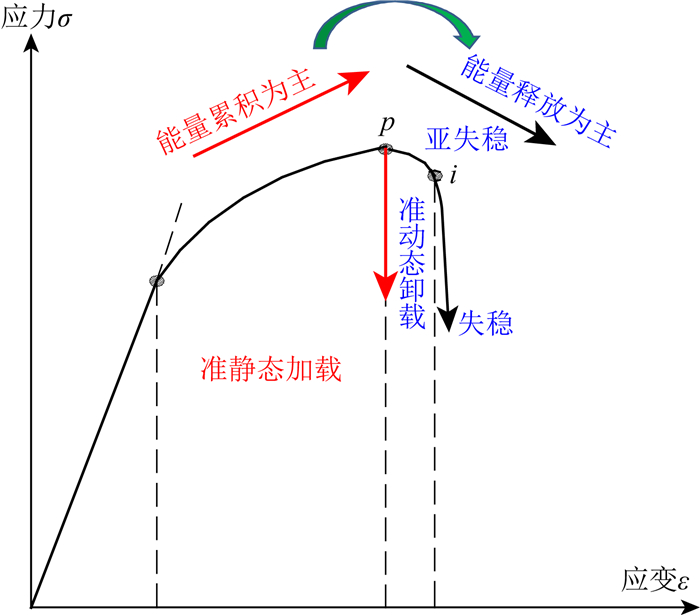
|
图 1 岩石力学实验显示的不同变形阶段示意图,其中p点为应力峰值点,p-i时段为亚失稳阶段 Fig. 1 Conceptual cartoon to illustrate different deformation stages of rock experiments in laboratory. The p point is peak stress and the time interval of p to i represents sub-instability stage |
亚失稳阶段在实验岩石样品的持续时间约为几秒的量级,高精度的实验观测手段有能力获得这短时段不同构造部位变形物理场的精细演化过程,但目前亚失稳阶段的影响因素尚不清楚,并且实验材料、加载速率等与实际地质体之间的相似性研究不足,因此实际地震前亚失稳阶段的持续时间及其可能的表现形式需要进一步深入研究,但整体上相应的物理场演化应体现出能量累积到能量释放的转变.
1 地震多发区应力分析方法震源区及潜在震源区应力场的研究一直是地震研究领域的热点和难点.地震为构造变形的突发事件,其震源机制包含了地震破裂面及错动的信息,基于共轭滑动断层分析构造应力的方法(Anderson,1951;Gzovsky, 1954, 1956)被引入到运用震源机制数据反演构造应力的研究中.在数据处理方法上前人做了大量开创性工作(Angelier et al., 1979, 1989; Ellsworth and Xu, 1980; Gephart and Forsyth, 1984; Michael, 1984; Xu et al., 1992), 推断出的构造应力张量中的四个应力分量包括三个应力主轴方位与应力形状系数已被广泛用来分析地壳应力场.由于应力张量可表示为(Nádai and Wahl, 1931)

|
(1) |
因此在获得四个应力分量后应力张量中只有平均应力p与最大剪应力τ为未知量, 等式(1)中方括号内表征了应力形状系数与三个应力主轴的方位.其中δij为Kronecker delta函数(i=j时δij=1, 其余为0),p=(σ1+σ2+σ3)/3, τ=|τmax|=(σ1-σ3)/2, lkj为主应力σk(k=1, 2, 3)在任意正交坐标系下的方向余弦,μσ=1-2φ, φ为应力形状系数.
在Angelier等(1979, 1989)的工作基础上Rebetsky等(2012, 2016)基于震源机制数据进一步开发了评价应力状态定量化参数的分析方法Method of Cataclastic Analysis(简称MCA),与经典应力反演方法中的均匀应力前提假定有所区别的是,MCA方法使用塑性理论一致性准则在给定数据中筛选出适合均匀应力场假定,即应力“同源区”的样本数据:

|
(2) |

|
(3) |

|
(4) |
即要求满足均匀应力条件下的每个地震造成的不可恢复塑性变形中伸长和缩短与应力主轴的拉张和挤压方向一致. σ1和σ3分别为最大主应力和最小主应力deiiα为地震造成的与主应力方向一致的拉伸与缩短塑性变形增量,可通过


|
(5) |
Byerlee(1968, 1978)通过对大量的不同岩石在不同压力条件下摩擦实验结果的综合分析,认为在高围压条件下断层剪切强度不依赖于岩石类型和断层面粗糙度,而与断层面正应力呈正比例线性关系,拟合摩擦系数为0.6.在获得各应力均匀分区的三个应力主轴方向及应力形状系数后,MCA方法基于上述线性关系发展了在各应力分区的地震震源机制节面中选择破裂面的方法,并将这些破裂面视为分布于应力摩尔圆的最小静摩擦线与近似强度包络线之间,设定数据中K点和B点分别控制最小静摩擦与内聚强度(图 2).如想构建出图 2所示的应力摩尔圆,未知信息为大摩尔圆的圆心σo*和半径τ.由应力张量表达式(1)可将平均应力分区中单个地震α所对应的断层面上剪应力和有效正应力及相应的简化应力


|
(6) |

|
(7) |
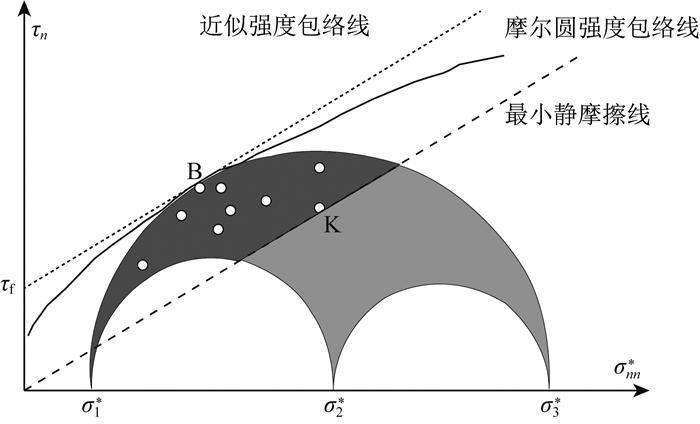
|
图 2 简化的摩尔圆脆性破坏区 图中灰色区域代表了不同方向节面的应力状态,其中深灰色区域为破裂强度区,不同点代表了应力同源区中各滑动面的正应力和剪应力. Fig. 2 Zone of brittle destruction on Mohr diagram Area of light grey color inside the big and above small circles of Mohr, defines stress states on the different orientation planes. Area of dark grey color means failure zone for restriction. Points within dark gray area are normal and shear stresses on the planes of slip faults from a homogeneous sample. The point K lies on the line of the minimum resistance of friction. |
其中
运用控制最小静摩擦的K点信息可获得有效平均应力p*与最大剪切强度τ之间存在的关系式:

|
(8) |
运用控制内聚强度τf的B点信息可最终获得剩余两个未知应力张量,即有效平均应力p*和最大剪应力τ相对岩石内聚力τf的归一化值:
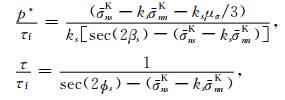
|
(9) |
其中
汶川大地震发生至今已近10年,震后有相关研究如地震活动性(张永久和张致伟,2010;马文涛等,2011)、钻孔应变测量等(Qiu et al., 2013;池顺良,2014)显示震前存在异常.造成这些异常现象的力学背景如何,与汶川强震的发生是否有必然联系?同震破裂达240 km(徐锡伟等,2010)的巨大地震在震前是否存在可观测的变形阶段等都是实验亚失稳理论与实际地震研究相结合的关键问题.
不同作者基于紫坪铺水库台网与成都数字地震台网的波形数据并运用振幅比方法(梁尚鸿等,1984)给出了汶川地震前龙门山断裂带的小震震源机制(张致伟等,2009;张永久和张致伟,2010;胡先明等,2009), 本文运用MCA方法对位于台站较密且数据密度相对较高的汶川地震微观震中附近的数据(张永久和张致伟,2010)(文献中图 2所示的A区和B区)开展了应力场演化分析,震级分布范围ML1.6~3.9.参与应力分析的计算点间隔为0.05°,通过多次试算选取每个应力“同源”区域的最大扫描半径不超过15 km,计算网格内符合应力“同源”假定的震源机制数据不少于6个,静摩擦系数取0.6,岩石内聚强度为0.1 kbar(1 bar=105Pa).最大扫描半径的选取对反演结果的影响较大,选取越小则应力“同源”区的可用数据就少,导致最终获得的应力结果越少;最大半径的选取如果偏大,虽然会得到更多点位的计算结果,但可能会导致一些数据在不同的计算区域都占有过大的权重,对最终的结果干扰较大.
应力分布显示紫坪铺水库台网观测前期不同时段有效平均应力水平随空间分布均匀、随时间平稳,临近汶川主震时段应力水平出现异常变化,因此对后期逐月数据扫描以确定应力发生明显变化的时间.图 3给出了不同时段有效平均应力归一化值的空间分布,显示出研究区在2007年6月前各时段有效平均应力水平分布均匀且相对较低,2007年6月应力水平异常变化,出现明显的非均匀性,震源附近应力水平显著增强,临震时间段(2007-06—2008-05-11)在紫坪铺库区东北角增加了新的应力增强区.
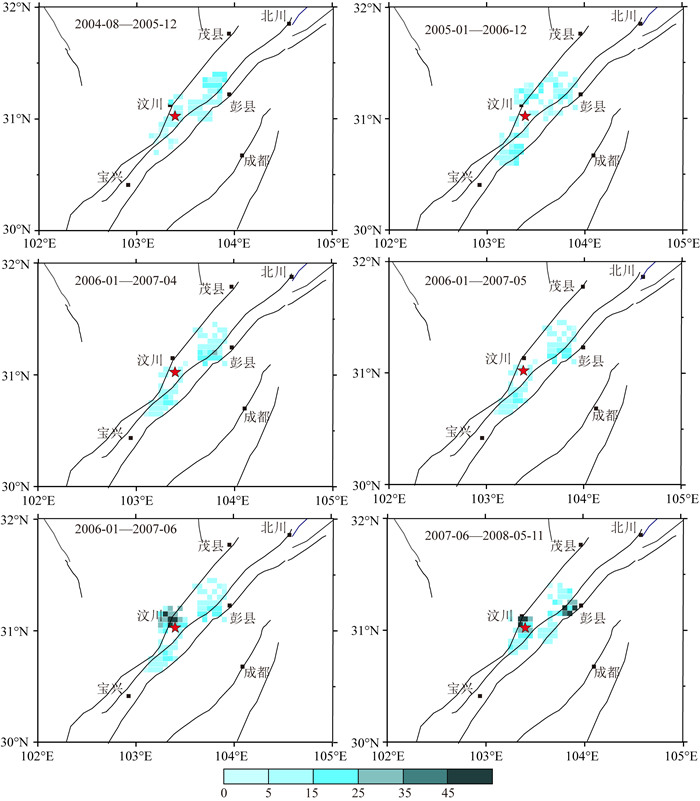
|
图 3 紫坪铺库区附近归一化的有效平均应力水平(p*/τf)在不同时段的空间分布 Fig. 3 Spatial distribution of normalized effective confining stress (p*/τf) around the Zipingpu reservoir at different time periods |
应力水平出现明显变化是否为震前的亚失稳过程?回答此问题需要抓住区域整体应力是否由应力累积为主转为以应力释放为主这一关键特征.将应力发生变化前的震源机制数据按时间分成两部分(2004年8月—2005年12月、2006年1月—2007年5月)并获得各自的应力水平分布,在此基础上对应力结果求取增量, 即对有共同坐标点的计算结果求差,视为有效平均应力随时间的增量场.从应力增量场可以看出研究区在此阶段主要以应力缓慢积累为主(图 4a);而同理获得的应力发生明显变化后时段相对变化前平稳时段的应力增量分布(2007年6月—2008年5月11日期间有效平均应力分布和基于2004年8月—2007年5月间的结果之差)却显示研究区除了汶川附近和彭县附近应力随时间增强,其他大部分区域有明显的应力释放(图 4b).这一结果表明研究区在上述应力变化前、后时段存在由应力缓慢积累为主转为应力明显释放占优势的可观测短临阶段,符合实验研究关于断层由稳态转为亚失稳状态的应力演化特征.

|
图 4 归一化有效应力(p*/τf)的增量在不同时段的空间分布:(a)为2004年8月—2005年12月、2006年1月—2007年5月两个时段的有效应力随时间增量分布;(b)为2004年8月—2007年5月、2007年6月至汶川地震前两个时段的有效应力随时间增量分布 Fig. 4 Spatial distribution of normalized effective stress increment at different time periods, stresses from January 2006 to May 2007 minus stresses from August 2004 to December 2005 (a), and stresses from June 2007 to the main Wenchuan earthquake minus stresses from August 2004 to May 2007 (b) |
以2007年6月为界给出了汶川地震前可能的稳态与亚失稳阶段的应力主轴与应力状态类型分布(图 5).结果显示该区域应力主轴方向分布较复杂,但2007年6月后的应力主轴方向(图 5b)在继承前一时段(图 5a)的基础上转为明显的有序分布,整体上最大主压应力轴呈NE和近NW向两种优势方位,与汶川地震序列震源机制显示的NE和NW两个优势挤压方向(Tian et al., 2013)相似;稳态阶段该区域应力状态类型(图 5c)复杂,主要表现为水平剪切和水平挤压应力类型,进入亚失稳阶段后该区域应力状态类型(图 5d)明显转变为均匀分布,以水平剪切应力状态为主兼有局部拉张,与同批数据的统计分析结果(张永久和张致伟,2010)显示的正断型地震归一化比例在此时段显著升高是一致的.
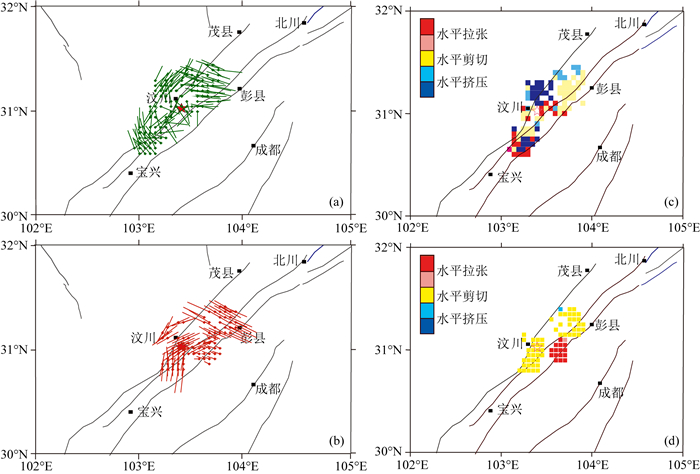
|
图 5 紫坪铺库区附近2004年8月—2007年5月(a, c)、2007年6月至汶川地震(b, d)两个时段的最大主压应力轴与应力状态类型的空间分布 Fig. 5 Spatial distribution of maximum compressive axes in the horizontal plane and stress state regimes around the Zipingpu reservoir from August 2004 to May 2007 (a, c) and from June 2007 to the 2008 Wenchuan earthquake(b, d) |
使用基于震源机制的定量应力状态分析方法对2008汶川地震震中附近紫坪铺水库台网测得的2004年8月至主震发生前的小震震源机制进行了分析,获得了不同时段归一化平均应力水平空间分布在震前的演化过程.结果显示2007年6月前不同时段的应力水平空间分布较均匀,随时间平稳,而在后期临震前出现了两处局部异常增强;对不同时段的应力水平随时间的增量进行了分析,显示应力水平均匀稳定期间的增量以缓慢的应力积累为主,而后期出现异常变化的应力水平与平稳期应力水平之间的增量显示了以释放为主的应力调整过程,与实验亚失稳阶段的特征表现一致.后期的应力主轴较前期转为更有序的分布,则可能是进入亚失稳阶段后震源区变形加速及伴随应力释放的断层预滑过程有关.
汶川地震的震源体巨大,破裂断层所在的龙门山断裂带为巴颜喀拉块体的东边界,推测出的汶川地震在龙门山推覆构造带中段产生了最大约7 m的地壳缩短量(徐锡伟等,2010),同震变形的量级应反映了间震期构造变形的累积,而这种变形累积应和块体相邻边界的变形协调.巴颜喀拉块体的南边界鲜水河断裂南段的短基线测量(刘冠中等,2013)显示鲜水河断裂左旋运动速率在约10年观测期间出现多次反向变化的趋势且变化时间与附近强震发生时间对应,在上述应力水平开始增强的时段即2007年中期鲜水河断裂南段的左旋活动也有明显转变;2008年汶川强震前紫坪铺水库台网测得的地震活动也显示出地震频度在2007年8月左右增强(张永久和张致伟,2010;马文涛等,2011); 四川姑咱台钻孔应变测量显示2007年8月后两组面应变数据反映出钻孔周围介质完整性开始出现明显变化, 推测为汶川地震在成核过程中震源区介质的连续性遭到逐渐破坏所致(Qiu et al., 2013;池顺良,2014).不同的研究手段从时间和空间上共同反映了汶川地震前震源断层及附近区域存在的联动加速变形,推测与震前孕震区亚失稳过程直接相关.
致谢四川省地震局张永久高级工程师为本研究提供了震源机制数据,两位评审专家对本文提出了宝贵意见,在此一并衷心感谢!
Anderson E M. 1951.
The Dynamics of Faulting and Dyke Formation with Applications to Britain. (2nd ed). Edinburgh: Oliver and Boyd.
|
|
Angelier J.
1979. Determination of the mean principal directions of stresses for a given fault population. Tectonophysics, 56(3-4): T17-T26.
DOI:10.1016/0040-1951(79)90081-7 |
|
Angelier J.
1989. From orientation to magnitudes in paleostress determinations using fault slip data. Journal of Structural Geology, 11(1-2): 37-50.
DOI:10.1016/0191-8141(89)90034-5 |
|
Byerlee J.
1978. Friction of rocks. Pure and Application Geophysics, 116(4-5): 615-626.
DOI:10.1007/BF00876528 |
|
Byerlee J D.
1968. Brittle-ductile transition in rocks. Journal of Geophysical Research, 73(14): 4741-4750.
DOI:10.1029/JB073i014p04741 |
|
Chi S L, Zhang J, Chi Y.
2014. Failure of self-consistent strain data before Wenchuan, Ludian and Kangding earthquakes and its relation with earthquake nucleation. Recent Developments in World Seismology, 47(12): 3-13, 47.
|
|
Ellsworth W L, Xu Z H.
1980. Determination of the stress tensor from focal mechanism data. EOS Trans AGU, 61: 1117.
|
|
Gephart J W, Forsyth D W.
1984. An improved method for determining the regional stress tensor using earthquake focal mechanism data: Application to the San Fernando earthquake sequence. Journal of Geophysical Research, 89(B11): 9305-9320.
DOI:10.1029/JB089iB11p09305 |
|
Gzovsky M V. 1954. Tectonic stress field. Izvestia Academian Science USSR. Series Geophysical, 3: 390-410 (in Russian).
https://www.sciencedirect.com/science/article/pii/S0040195112006282 |
|
Gzovsky M V. 1956. Relation between tectonic faults and stresses in the Earth's crust. Exploration and Protection of Natural Resources, 11. Nauka, Moscow, 7-22 (in Russian).
|
|
Hu X M, Zhang Y J, Xie R H, et al.
2009. Research on focal mechanism of small earthquakes in Zipingpu reservoir area. Seismology and Geology, 31(4): 676-685.
|
|
Kostrov B V. 1975. Mechanics of the Source of a Tectonic Earthquake. Moscow: Nauka Press, 176. (in Russia).
https://link.springer.com/article/10.1007/BF00881602 |
|
Kostrov B V, Das S. 1989. Principles of Earthquake Source Mechanics. Cambridge: Cambridge University Press, 174.
|
|
Liang S H, Li Y M, Shu P Y, et al.
1984. On the determining of source parameters of small earthquakes by using amplitude ratios of P and S from regional network observations. Chinese Journal of Geophysics, 27(3): 249-257.
|
|
Liu G Z, Ma J, Zhang H X, et al.
2013. Study on activity features of Xianshuihe fault zone with fault creep and short baseline observation for the last 20 years. Chinese Journal of Geophysics, 56(3): 878-891.
DOI:10.6038/cjg20130317 |
|
Ma J, Guo Y S.
2014. Accelerated synergism prior to fault instability: Evidence from laboratory experiments and an earthquake case. Seismology and Geology, 36(3): 547-561.
|
|
Ma J.
2016. On "whether earthquake precursors help for prediction do exist". Chinese Science Bulletin, 61(4-5): 409-414.
|
|
Ma W T, Xu C P, Zhang X D, et al.
2011. Study on the relationship between the reservoir-induced seismicity at Zipingpu reservoir and the MS8.0 Wenchuan earthquake. Seismology and Geology, 33(1): 175-190.
|
|
Michael A J.
1984. Determination of stress from slip data: Faults and folds. Journal of Geophysical Research: Solid Earth, 89(B13): 11517-11526.
DOI:10.1029/JB089iB13p11517 |
|
Nádai A. 1931.
Plasticity, A Mechanics of the Plastic State of Matter. New York: McGraw-Hill Book: 349.
|
|
Qiu Z H, Yang G, Tang L, et al.
2013. Abnormal strain changes observed by a borehole strainmeter At Guza station before the MS7. 0 Lushan earthquake. Geodesy and Geodynamics, 4(3): 19-29.
DOI:10.3724/SP.J.1246.2013.03019 |
|
Rebetsky Y L, Kuchai O A, Sycheva N A, et al.
2012. Development of inversion methods on fault slip data: Stress state in orogenes of the Central Asia. Tectonophysics, 581: 114-131.
DOI:10.1016/j.tecto.2012.09.027 |
|
Rebetsky Y L, Polets A Y, Zlobin T K.
2016. The state of stress in the Earth's crust along the northwestern flank of the Pacific seismic focal zone before the Tohoku earthquake of 11 March 2011. Tectonophysics, 685: 60-76.
DOI:10.1016/j.tecto.2016.07.016 |
|
Ren Y Q, Ma J, Liu P X, et al.
2017. Experimental study of thermal field evolution in the short-impending stage before Earthquakes. Pure and Applied Geophysics.
DOI:10.1007/s00024-017-1626-7 |
|
Tian Y, Ning J Y, Yu C Q, et al.
2013. Focal mechanism solutions of the 2008 Wenchuan earthquake sequence from P-wave polarities and SH/P amplitude ratios: New results and implications. Earthquake Science, 26(6): 357-372.
DOI:10.1007/s11589-014-0067-y |
|
Xu X W, Chen G H, Yu G H, et al.
2010. Reevaluation of surface rupture parameters of the 5·12 Wenchuan earthquake and its tectonic implication for Tibetan uplift. Chinese Journal of Geophysics, 53(10): 2321-2336.
DOI:10.3969/j.issn.0001-5733.2010.10.006 |
|
Xu Z H, Wang S Y, Huang Y R, et al.
1992. Tectonic stress field of China inferred from a large number of small earthquakes. Journal of Geophysical Research: Solid Earth, 97(B8): 11867-11877.
DOI:10.1029/91JB00355 |
|
Zhang Y J, Zhang Z W.
2010. The focal mechanisms and characteristic of stress field in Zipingpu area before Wenchuan earthquake. Seismology and Geology, 32(4): 614-627.
|
|
Zhang Z W, Cheng W Z, Ruan X, et al.
2009. Seismicity and tectonic stress of the Longmenshan fault zone before 2008 Wenchuan MS8.0 earthquake. Acta Seismologica Sinica, 31(2): 117-127.
|
|
Zhuo Y Q, Guo Y S, Ji Y T, et al.
2013. Slip synergism of planar strike-slip fault during meta-instable state: Experimental research based on digital image correlation analysis. Science China Earth Sciences, 56(11): 1881-1887.
DOI:10.1007/s11430-013-4623-4 |
|
Zhuo Y Q, Ma J, Guo Y S, et al.
2015. Identification of the meta-instability stage via synergy of fault displacement: An experimental study based on the digital image correlation method. Physics and Chemistry of the Earth, 85-86: 216-224.
DOI:10.1016/j.pce.2015.03.002 |
|
池顺良, 张晶, 池毅.
2014. 汶川、鲁甸、康定地震前应变数据由自洽到失洽的转变与地震成核. 国际地震动态, 47(12): 3–13, 47.
DOI:10.3969/j.issn.0235-4975.2014.12.003 |
|
胡先明, 张永久, 谢蓉华, 等.
2009. 紫坪铺水库区小地震震源机制研究. 地震地质, 31(4): 276–285.
|
|
刘冠中, 马瑾, 张鸿旭, 等.
2013. 二十年来蠕变和短基线观测反映的鲜水河断裂带活动特征. 地球物理学报, 56(3): 878–891.
DOI:10.6038/cjg20130317 |
|
马文涛, 徐长朋, 张新东, 等.
2011. 紫坪铺水库与汶川地震关系的讨论. 地震地质, 33(1): 175–190.
|
|
马瑾, 郭彦双.
2014. 失稳前断层加速协同化的实验室证据和地震实例. 地震地质, 36(3): 547–561.
|
|
马瑾.
2016. 从"是否存在有助于预报的地震先兆"说起. 科学通报, 61(4-5): 409–414.
|
|
徐锡伟, 陈桂华, 于贵华, 等.
2010. 5﹒12汶川地震地表破裂基本参数的再论证及其构造内涵分析. 地球物理学报, 53(10): 2321–2336.
DOI:10.3969/j.issn.0001-5733.2010.10.006 |
|
张永久, 张致伟.
2010. 汶川8.0级地震前紫坪铺库区震源机制及应力场特征. 地震地质, 32(4): 614–627.
|
|
张致伟, 程万正, 阮祥, 等.
2009. 汶川8.0级地震前龙门山断裂带的地震活动性和构造应力场特征. 地震学报, 31(2): 117–127.
|
|
 2018, Vol. 61
2018, Vol. 61

